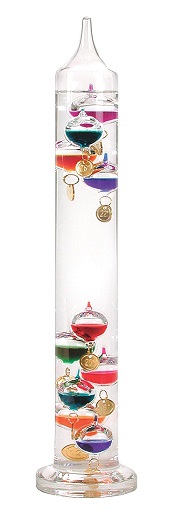Galileo Thermometer

In addition to being aesthetically pleasing to look at, the Galileo thermometer is a good way to teach the physics of density. It is a fact that the density of a liquid changes in proportion to its temperature.
Check out a time-lapse video of the Galileo thermometer:
If an object is denser than a liquid, it will sink in that liquid. If an object is less dense than the liquid, it will float in that liquid. Such an object will partially sink until the weight of the liquid it displaces becomes equal to the weight of the object. This means that some of the object will protrude above the liquid surface.
The clear liquid inside the Galileo thermometer is not water, but is another liquid, typically ethanol, whose density varies with temperature more than the density of water does. This makes it more sensitive to temperature changes which makes it a better predictor for temperature than water. As the temperature of the surroundings changes, the temperature of the thermometer and liquid inside changes in order to match this temperature. This affects the density of the liquid, which then causes some bulbs to rise and some to sink to the bottom. The bulbs that rise are less dense than the liquid, and the ones that sink are more dense than the liquid.
The bulbs are sized so as not to jam with each other as they move up or down in the tube. They are either at least half the size of the inner tube diameter, in order to maintain their stacking order, or their size is much less than the inner tube diameter, in order to allow them to freely pass each other as they move up or down.
In some thermometers, if there are some bulbs at the top of the tube, some at the bottom, and one floating in the gap, the one floating in the gap tells the temperature. If there is no bulb in the gap then the average of the values of the top and bottom bulbs gives the approximate temperature. In other thermometers, the lowest floating bulb gives the approximate temperature.
Return to Science Toys page
Return to Real World Physics Problems home page
Free Newsletter
Subscribe to my free newsletter below. In it I explore physics ideas that seem like science fiction but could become reality in the distant future. I develop these ideas with the help of AI. I will send it out a few times a month.